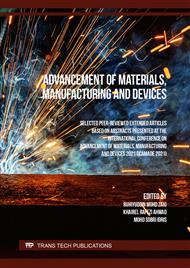[1]
Vasawade, S. D., Paramaje, S. S., Choudhari, N. J., Grampurohit, B. V., Rendale, M. K., Mathad, S. N., Hiremath, C. S. & Pujar, R. B. (2018). Structural and dielectric properties of lead-free Zr-doped barium titanates. International Journal of Self-Propagating High-Temperature Synthesis, 27(1), 26-32.
DOI: 10.3103/s1061386218010119
Google Scholar
[2]
Wegner, M., Gu, H., James, R. D., & Quandt, E. (2020). Correlation between phase compatibility and efficient energy conversion in Zr-doped Barium Titanate. Scientific reports, 10(1), 1-8.
DOI: 10.1038/s41598-020-60335-5
Google Scholar
[3]
Muhsen, K. N. D. K., Osman, R. A. M., & Idris, M. S. (2020). The effects of Ca, Zr and Sn substitutions into a ternary system of BaTiO3–BaSnO3–BaZrO3 towards its dielectric and piezoelectric properties: a review. Journal of Materials Science: Materials in Electronics, 1-13.
DOI: 10.1007/s10854-020-03756-2
Google Scholar
[4]
Muhsen, K. N. D. K., Osman, R. A. M., & Idris, M. S. (2019). Structure refinement and impedance analysis of Ba0.85Ca0.15Zr0.10Ti0.90O3 ceramics sintered in air and nitrogen. Journal of Materials Science: Materials in Electronics, 30(23), 20673-20686.
DOI: 10.1007/s10854-019-02433-3
Google Scholar
[5]
Qi, J. Q., Liu, B. B., Tian, H. Y., Zou, H., Yue, Z. X., & Li, L. T. (2012). Dielectric properties of barium zirconate titanate (BZT) ceramics tailored by different donors for high voltage applications. Solid state sciences, 14(10), 1520-1524.
DOI: 10.1016/j.solidstatesciences.2012.08.009
Google Scholar
[6]
Mahesh, M. L. V., Pal, P., Prasad, V. B., & James, A. R. (2020). Improved properties & fatigue resistant behaviour OF Ba(Zr0.15Ti0.85)O3 ferroelectric ceramics. Current Applied Physics, 20(12), 1373-1378.
DOI: 10.1016/j.cap.2020.08.016
Google Scholar
[7]
Muhsen, K. N. D. K., Osman, R. A. M., & Idris, M. S. (2019). Giant anomalous dielectric behaviour of BaSnO3 at high temperature. Journal of Materials Science: Materials in Electronics, 30(8), 7514-7523.
DOI: 10.1007/s10854-019-01065-x
Google Scholar
[8]
Osman, R. A., & West, A. R. (2011). Electrical characterization and equivalent circuit analysis of (Bi1.5Zn0.5)(Nb0.5Ti1.5)O7 Pyrochlore, a relaxor ceramic. Journal of Applied Physics, 109(7), 074106.
DOI: 10.1063/1.3553883
Google Scholar
[9]
Irvine, J. T., Sinclair, D. C., & West, A. R. (1990). Electroceramics: characterization by impedance spectroscopy. Advanced materials, 2(3), 132-138.
DOI: 10.1002/adma.19900020304
Google Scholar
[10]
Sun, Z., Pu, Y., Dong, Z., Hu, Y., Liu, X., & Wang, P. (2014). Effect of Zr4+ content on the TC range and dielectric and ferroelectric properties of BaZrxTi1− xO3 ceramics prepared by microwave sintering. Ceramics International, 40(2), 3589-3594.
DOI: 10.1016/j.ceramint.2013.09.069
Google Scholar



